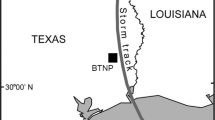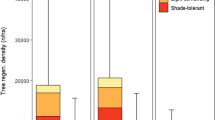Abstract
This study examined historical census data to evaluate the vulnerability of major tall-tree species in northern Japan to strong winds. Intensive data, which measured more than 20,000 damaged trees (defined as trees that were killed or lost their major crown) in >500 ha of a natural mixed forest, were collected immediately after a severe typhoon in 1954. More than half of the damaged trees had been uprooted, and the negative size-dependency was found for the proportion of uprooting throughout species. Simple correlation analyses with respect to the averaged species-specific characteristics suggested that tree species with a high crown-depth/height tended to uproot (against to stem breakage) in a size-class with diameter at breast height 30–50 cm. Although the census data had yielded no information about non-damaged trees, the estimation of pre-disturbed stand (based on 63 1-ha plot data together with aerial photographs and GIS) revealed that the observed damage reached ca. 25% in terms of basal area. The proportion of damaged trees seemed to be doubled among species (15–42% in basal area). A higher proportion of uprooting, which indicates a large supply of tip-up mounds, and mixture of less vulnerable species, might contribute to recovery process after a wind disturbance in this type of mixed forests.





Similar content being viewed by others
References
Achim A, Ruel JC, Gardiner BA, Laflamme G, Meunier S (2005) Modeling the vulnerability of balsam fir forests to wind damage. For Ecol Manage 204:35–50
Ancelin P, Courbaud B, Fourcaud T (2004) Development of an individual tree-based mechanical model to predict wind damage within forest stands. For Ecol Manage 203:101–121
Arevalo JR, DeCoster JK, McAlister SD, Palmer MW (2000) Changes in two Minnesota forests during 14 years following catastrophic windthrow. J Veg Sci 11:833–840. doi:10.2307/3236553
Beatty SW (1984) Influence of microtopography and canopy species on spatial patterns of forest understory plants. Ecology 65:1406–1419. doi:10.2307/1939121
Canham CD, Papalik MJ, Latty EF (2001) Interspecific variation in susceptibility to windthrow as a function of tree size and storm severity for northern temperate tree species. Can J For Res 31:1–10. doi:10.1139/cjfr-31-1-1
Dyer JM, Baird PR (1997) Wind disturbance in remnant forest stands along the prairie-forest ecotone, Minnesota, USA. Plant Ecol 129:121–134. doi:10.1023/A:1009761013081
Elie JG, Ruel JC (2005) Windthrow hazard modeling in boreal forests of black spruce and jack pine. Can J For Res 35:2655–2663. doi:10.1139/x05-189
Everham EM, Brokaw NVL (1996) Forest damage and recovery from catastrophic wind. Bot Rev 62:113–185. doi:10.1007/BF02857920
Foster DR (1988) Disturbance history, community organization and vegetation dynamics of the old-growth Pisgah forest, south-western New Hampshire, USA. J Ecol 76:105–134. doi:10.2307/2260457
Foster DR, Boose ER (1992) Patterns of forest damage resulting from catastrophic wind in central New England, USA. J Ecol 80:79–98. doi:10.2307/2261065
Gardiner BA, Quin CP (2000) Management of forests to reduce the risk of abiotic damage––a review with particular reference to the effects of strong winds. For Ecol Manage 135:261–277
Gardiner BA, Peltola H, Kellomaki S (2000) Comparison of two models for predicting the critical wind speeds required to damage coniferous trees. Ecol Modell 179:259–279
Ishizuka M, Toyooka H, Osawa A, Kushima H, Kanazawa Y, Soto A (1998) Secondary succession following catastrophic windthrow in a boreal forest in Hokkaido, Japan: the timing of tree establishment. J Sustain For 6:367–388. doi:10.1300/J091v06n03_08
Karizumi N (1979) Illustrations of tree roots (in Japanese). Seibundo Shinkosha, Tokyo
King DA (1986) Tree form, height growth, and susceptibility to wind damage in Acer saccharum. Ecology 67:980–990. doi:10.2307/1939821
Koike T (1988) Leaf structure and photosynthetic performance as related to the forest succession of deciduous broad-leaved trees. Plant Species Biol 3:77–87. doi:10.1111/j.1442-1984.1988.tb00173.x
Kubota Y (2000) Spatial dynamics of regeneration in a conifer/broad-leaved forest in northern Japan. J Veg Sci 11:633–640. doi:10.2307/3236570
Masaki T (2002) Structure and dynamics. In: Nakashizuka T, Matsumoto Y (eds) Diversity and interaction in a temperate forest community: Ogawa forest reserve of Japan. Springer, Berlin Heidelberg New York, pp 53–65
Matlack GR, Glesson SK, Good RE (1993) Treefall in a mixed oak-pine coastal plain forest: immediate and historical causation. Ecology 74:1559–1566. doi:10.2307/1940083
Mishima T, Taniguchi S, Taniguchi M (1955) The actual states of wind damage in the Tomakomai Experimental Forest of Hokkaido University (1) on the plantation of strange land species (in Japanese with English summary). Res Bull Coll Exp For Hokkaido Univ 17:715–748
Mishima T, Taniguchi S, Taniguchi M (1958) The actual states of wind damage in the Tomakomai Experimental Forest of Hokkaido University (2) on the natural forest (in Japanese with English summary). Res Bull Coll Exp For Hokkaido Univ 19:1–39
Miyajima H (1959) Compression failures in wood from trees damaged by Typhoon 15 of 1954 (in Japanese with English summary). Res Bull Coll Exp For Hokkaido Univ 20:197–208
Nakashizuka T (1989) Role of uprooting in composition and dynamics of an old-growth forest in Japan. Ecology 70:1273–1278. doi:10.2307/1938186
Nakashizuka T, Iida S (1995) Composition, dynamics and disturbance regime of temperate deciduous forests in Monsoon Asia. Vegetatio 121:23–30. doi:10.1007/BF00044669
Nieuwenhuis M, Fitzpatrick PJ (2002) An assessment of stem breakage and the reduction in timber volume and value recovery resulting from a catastrophic storm: an Irish case study. Forestry 75:513–523. doi:10.1093/forestry/75.5.513
Noguchi M, Yoshida T (2004) Tree regeneration in partially cut conifer-hardwood mixed forests in northern Japan: roles of establishment substrate and dwarf bamboo. For Ecol Manage 190:335–344
Ogle K, Uriarte M, Thompson J, Johnstone J, Jones A, Lin Y, Mclntire EJB, Zimmerman JK (2006) Implications of vulnerability to hurricane damage for long-term survival of tropical tree species: a Bayesian hierarchical analysis. In: Clark JS, Gelfand AE (eds) Hierarchical modeling for the environmental sciences: statistical methods and applications. Oxford University Press, Oxford, pp 98–117
Peterson CJ (2000) Damage and recovery of tree species after two different tornadoes in the same old growth forest: a comparison of infrequent wind disturbances. For Ecol Manage 135:237–252
Peterson CJ (2004) Within-stand variation in windthrow in southern boreal forests of Minnesota: is it predictable? Can J For Res 34:365–375. doi:10.1139/x03-257
Peterson CJ (2007) Consistent influence of tree diameter and species on damage in nine eastern North America tornado blowdowns. For Ecol Manage 250:96–108
Peterson CJ, Pickett STA (2000) Patch type influences on components of forest regeneration in a western Pennsylvania (USA) catastrophic windthrow. Oikos 90:489–500. doi:10.1034/j.1600-0706.2000.900307.x
Peterson CJ, Pickett STA (1991) Treefall and resprouting following catastrophic windthrow in an old-growth hemlock-hardwood forest. For Ecol Manage 42:205–217
Peterson CJ, Rebertus AJ (1997) Tornado damage and initial recovery in three adjacent, lowland temperate forests in Missouri. J Veg Sci 8:559–564. doi:10.2307/3237207
Peltola H, Kellomaki S (1993) A mechanistic model for calculating windthrow and stem breakage at stand edge. Silva Fenn 27:99–111
Putz FE, Sharitz RR (1991) Hurricane damage to old-growth forest in Congaree Swamp National Monument, South Carolina, USA. Can J For Res 21:1765–1770. doi:10.1139/x91-244
Putz FE, Coley PD, Lu K, Montalvo A, Aiello A (1983) Uprooting and snapping of trees: structural determinants and ecological consequences. Can J For Res 13:1011–1020. doi:10.1139/x83-133
Ray D, Nicoll BC (1998) The effect of soil water-table depth on root-plate development and stability of Sitka spruce. Forestry 71:169–182. doi:10.1093/forestry/71.2.169
Ruel JC (2000) Factors influencing windthrow in balsam fir forests: from landscape studies to individual tree studies. For Ecol Manage 135:169–178
Saito S, Sato T (2007) Characteristics of typhoon damage to major tree species in a lucidophyllous forest: a comparison of tree species responses to several typhoons at the Aya long-term ecological research site (in Japanese with English summary). J Jpn For Soc 89:321–328
Scott RE, Mitchell SJ (2005) Empirical modeling of windthrow risk in partially harvested stands using tree, neighborhood, and stand attributes. For Ecol Manage 218:193–209
Suzuki E, Ota K, Fujiwara K (1987) Regeneration process of coniferous forests in northern Hokkaido: Abies sachalinensis forest and Picea glehnii forest. Ecol Res 2:61–75. doi:10.1007/BF02348620
Takahashi K, Mitsuishi D, Uemura S, Suzuki J, Hara T (2003) Stand structure and dynamics during a 16-year period in a sub-boreal conifer-hardwood mixed forest, northern Japan. For Ecol Manage 174:39–50
The Scientific Investigation Group of the Wind-damaged forests in Hokkaido (1959) A report of the scientific investigations of the forests wind-damaged in 1954, Japan (in Japanese). Japan Forest Technical Association, Tokyo, p 535
Webb SL (1989) Contrasting windstorm consequences in two forests, Itasca State Park, Minnesota. Ecology 70:1167–1180. doi:10.2307/1941384
Webb SL (1999) Disturbance by wind in temperate-zone forests. In: Walker LR (ed) Ecosystems of disturbed ground. Elsevier, Amsterdam, pp 187–222
Webb SL, Scanga S (2001) Windstorm disturbance without patch dynamics: twelve years of change in a Minnesota forest. Ecology 82:893–897
Webster PJ, Holland GJ, Curry JA, Chang HR (2005) Changes in tropical cyclone number, duration, and intensity in a warming environment. Science 309:1844–1846. doi:10.1126/science.1116448
Wood Technology and Wood Utilization Division (1982) Properties of the important Japanese woods. Table of the properties of woods (Research note) (in Japanese with English summary). Bull Forest and Forest Products Res Inst 319:85–126
Yoshida T, Noguchi M, Akibayashi Y, Noda M, Kadomatsu M, Sasa K (2006) Twenty years of community dynamics in a mixed conifer-broadleaved forest under a selection system in northern Japan. Can J For Res 36:1363–1375. doi:10.1139/X06-041
Acknowledgments
We are grateful to anonymous reviewers for helpful comments. We also thank the staff of the Uryu Experimental Forest for the fieldwork and the data keeping. Thanks are also extended to A. Koizumi and S. Funakoshi for their providing references. This study was partly supported by the research projects fund from the Ministry of Education, Culture, Sports, Science and Technology of Japan (No. 17580123).
Author information
Authors and Affiliations
Corresponding author
Appendix
Appendix
About this article
Cite this article
Yoshida, T., Noguchi, M. Vulnerability to strong winds for major tree species in a northern Japanese mixed forest: analyses of historical data. Ecol Res 24, 909–919 (2009). https://doi.org/10.1007/s11284-008-0566-1
Received:
Accepted:
Published:
Issue Date:
DOI: https://doi.org/10.1007/s11284-008-0566-1




